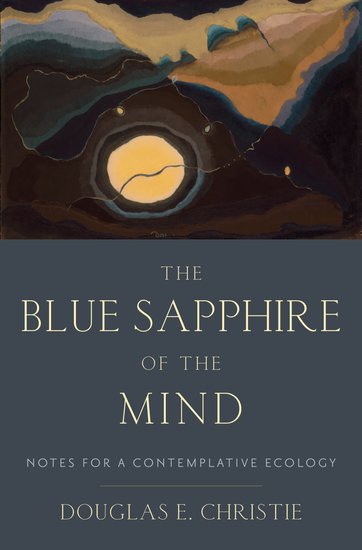There is a deep and pervasive hunger for a less fragmented and more integrated way of understanding and inhabiting the world. What must change if we are to live in a sustainable relationship with other organisms? What role do our moral and spiritual values play in responding to the ecological crisis? We sat down with Douglas E. Christie, author of The Blue Sapphire of the Mind, to discuss a contemplative approach to ecological thought and practice that can help restore our sense of the earth as a sacred place.

What is the blue sapphire of the mind?
It is an image used by Evagrius of Pontus, a fourth century Christian monk, to describe the condition of the mind transformed by contemplative practice: it is pure and endless and serene, capable of seeing and experiencing union with everything and everyone.
What is “contemplative ecology” and what does it have to do with this idea?
Contemplative ecology has two distinct but related meanings. First, it refers to a particular way of thinking about and engaging ecological concerns, rooted in a distinctive form of contemplative spiritual practice. Second, it refers to a particular way of thinking about spiritual practice, one that understands the work of transforming awareness as leading toward and including a deepened understanding of the intricate relationships among and between all living beings. The underlying concern is to find new ways of thinking about the meaning and significance of the relationship between ecological concern and contemplative spiritual practice, that can help to ground sustained care for the environment in a deep feeling for the living world.
What possible meaning do you think such a contemplative approach can have in an age of massive and growing environmental degradation?
Contemplative traditions of spiritual practice, including those grounded in monastic forms of living, have long occupied the margins of mainstream society. The work of such communities is often hidden from view. Because of this, their contributions to work of social and political transformation can seem, on the face of it, negligible. But a careful examination of the historical record suggests that such communities have contributed and continue to contribute significantly to the project of cultural, social and even political renewal — primarily through their unwavering commitment to uncovering the deepest sources of our bonds with one another and with the living world. In our own moment of ecological and political crisis, these traditions of contemplative thought and practice can help to awaken in us a new awareness of the deepest sources of our shared concern for the world.
Is this a matter of particular concern to religious communities?
Yes, and no. Certainly, environmental degradation is a concern that religious communities around the world are waking up to in a new way, and this includes the particular contributions of monastic communities. But the distinctively contemplative dimension of this renewal transcends religion (at least in narrow terms) and touches on a wider and more fundamental human concern: to truly know ourselves as part of the rich web of life. Contemplative ecology addresses anyone who wishes to think more deeply and carefully about what it is to be alive and attentive to the natural world, and to respond with care and affection.
Douglas E. Christie is Professor of Theological Studies, Loyola Marymount University, and the author of The Blue Sapphire of the Mind: Notes for a Contemplative Ecology and The Word in the Desert: Scripture and the Quest for Holiness in Early Christian Monasticism.
Subscribe to the OUPblog via email or RSS.
Subscribe to only religion articles on the OUPblog via email or RSS.
Image credit: Dissolving fractured head. Photo by morkeman, iStockphoto.



Recent Comments
There are currently no comments.